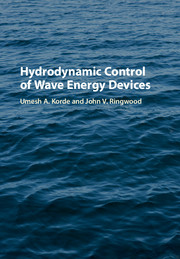Book contents
- Frontmatter
- Contents
- Preface
- Acknowledgments
- Part I Introduction
- 1 Wave Energy Conversion
- Part II The Basics
- Part III The Hydrodynamics
- Part IV Velocity Control Using a Hydrodynamic Model
- Part V Control by Optimizing a Performance Index
- Part VI Toward Overall WEC System Hydrodynamic Optimization
- Part VII In Closing
- References
- Index
1 - Wave Energy Conversion
from Part I - Introduction
Published online by Cambridge University Press: 05 September 2016
- Frontmatter
- Contents
- Preface
- Acknowledgments
- Part I Introduction
- 1 Wave Energy Conversion
- Part II The Basics
- Part III The Hydrodynamics
- Part IV Velocity Control Using a Hydrodynamic Model
- Part V Control by Optimizing a Performance Index
- Part VI Toward Overall WEC System Hydrodynamic Optimization
- Part VII In Closing
- References
- Index
Summary
Who can contemplate the surface of the ocean and not notice its incessant, seemingly random motion? This motion represents the net effect of long swells bearing memories of distant storms, shorter waves driven up by winds blowing nearby and over the surrounding area, and very small ripples caused by surface tension, with the pattern constantly changing and its constituents continuously traveling in different directions. Closer to shore, the ocean surface seems dominated by waves of steeper slopes with aligned crests mostly traveling towards the shore. As the crests approach the shore they get steeper, slightly disintegrating near their tops but still getting taller until they turn into plunging, roaring breakers, finally giving up their energy as they dissipate (with some reluctance) over sandy beaches or rocky shores. Whether maneuvering (or simply observing) a small craft on its way through the waves, or watching the waves crash loudly onto the beach, one can hardly fail to be impressed by their unrelenting display of energy.
Waves as Energy Carriers
Waves carry energy from one point to another. One observes an excellent illustration of this phenomenon when the relatively calm surface of a pond or a small lake is disturbed by a pebble or a small stone thrown into the water. A pattern of waves emanates from where the stone fell, traveling radially out and creating ever-expanding circles with alternating crests and troughs that get smaller, the farther the disturbance travels. In this case, waves carry away a portion of the kinetic energy of the stone over the water surface. A roughly similar phenomenon occurs when wind blows over a region of the ocean surface and generates waves that are higher and longer, the faster and longer the wind blows. In deep waters, the dissipation rate of the energy contained in waves is very small, enabling them to last longer and travel farther than the wind that created them. This happens for wind blowing over different regions, leading to an averaging, storing, and concentration of energy, both spatially and temporally. Because the density of sea water is about three orders of magnitude greater than that of air, energy delivered by waves is also more concentrated than wind energy.
- Type
- Chapter
- Information
- Hydrodynamic Control of Wave Energy Devices , pp. 3 - 30Publisher: Cambridge University PressPrint publication year: 2016



